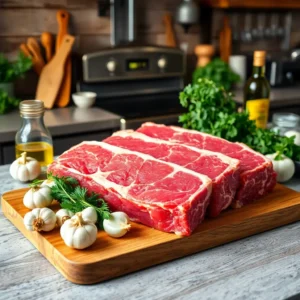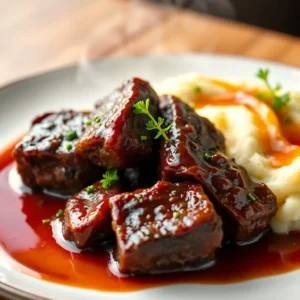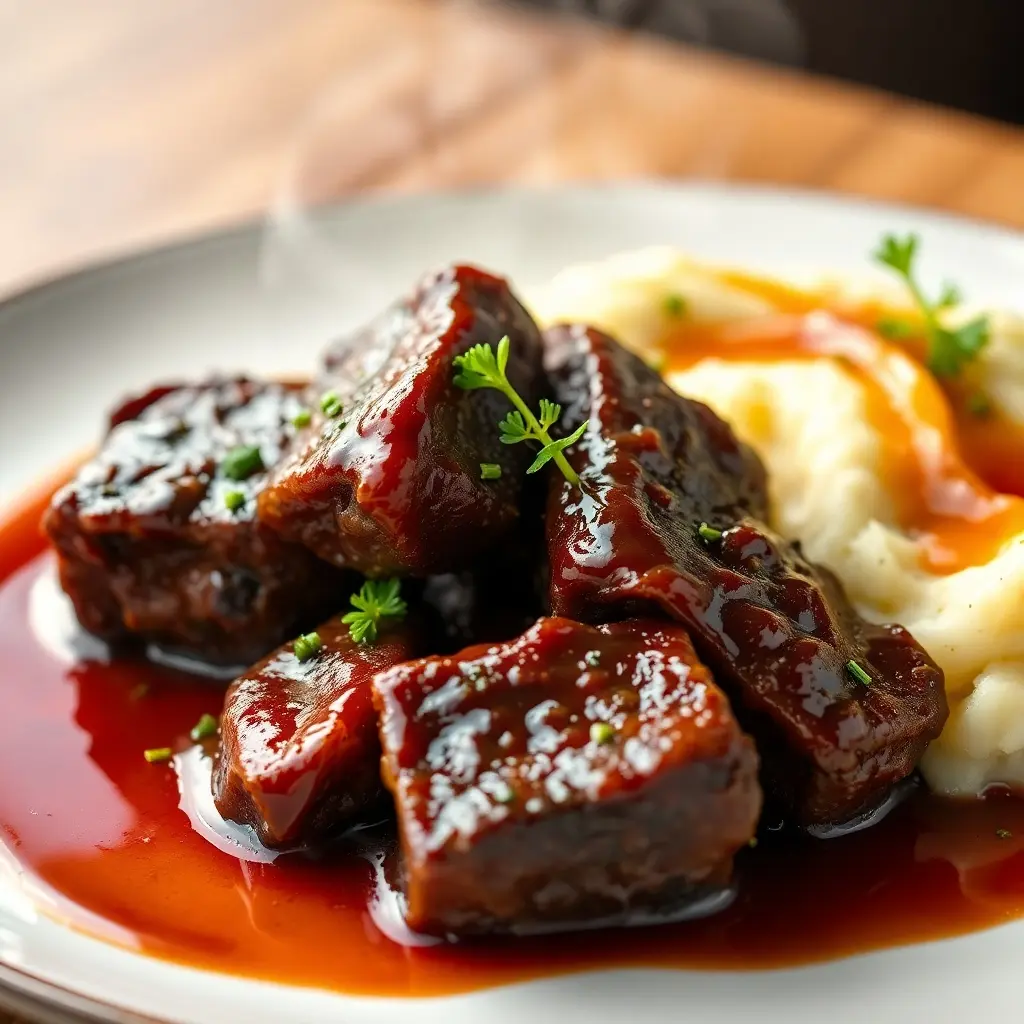Beef short ribs are a beloved comfort food, admired for their rich, beefy flavor and melt-in-your-mouth texture. Whether slow-cooked, braised, or grilled, these ribs can transform into a gourmet masterpiece with the right techniques and ingredients. This article dives deep into the world of beef short ribs recipes, covering everything from choosing the best cuts to mastering various cooking methods and serving ideas.
Introduction to Beef Short Ribs
What Are Beef Short Ribs?
Beef short ribs, cut from the lower section of the ribcage, are a culinary gem cherished worldwide. They come in two primary forms: English cut and flanken cut, each offering unique textures and cooking possibilities. The English cut consists of longer pieces of rib with meat on top, perfect for braising or slow cooking. On the other hand, the flanken cut features thinner slices across multiple ribs, ideal for grilling or quick cooking.
Their versatility is what makes beef short ribs recipes so appealing. You can braise them in a hearty sauce, slow-cook them until they’re fall-off-the-bone tender, or char them to perfection on a grill. The possibilities are endless!
Why Choose Beef Short Ribs?
The allure of beef short ribs lies in their deep, robust flavor, which only intensifies with slow cooking. Thanks to their marbling, these ribs remain juicy and tender when prepared correctly. They’re also versatile enough to fit into various cuisines, from American comfort food to Korean-inspired dishes.
Moreover, short ribs are affordable compared to other premium beef cuts, making them an excellent choice for home cooks looking to impress without breaking the bank. With just a bit of preparation and patience, you can elevate this humble cut into a show-stopping dish.
Selecting the Perfect Beef Short Ribs
 Understanding Different Cuts
Understanding Different Cuts
When it comes to beef short ribs recipes, selecting the right cut can make or break the dish. Short ribs come in two main styles: English cut and flanken cut, each suited to specific cooking methods.
- English Cut: These ribs are longer, with meat stacked atop the bone. They’re ideal for slow cooking and braising, as the cut allows the flavors to seep deep into the meat.
- Flanken Cut: This style features thin slices cut across the bone, with multiple small bone pieces in each section. It’s perfect for quick cooking methods like grilling or stir-frying.
Understanding these cuts helps you choose the one that matches your recipe and desired cooking style.
Tips for Choosing Quality Ribs
Finding top-quality beef short ribs is the first step toward a dish that wows your taste buds. Look for ribs with visible marbling—thin streaks of fat running through the meat. This fat renders during cooking, ensuring juicy, flavorful results.
Freshness is another critical factor. Opt for meat that’s bright red with no gray or dull patches, as this indicates freshness. When in doubt, consult your butcher, who can guide you toward the best ribs for your recipe.
Sustainability and Ethical Sourcing
Selecting sustainably sourced beef short ribs not only ensures quality but also supports responsible farming practices. Look for certifications like USDA Organic or grass-fed labels. With your perfect ribs in hand, you’re one step closer to a meal that’s as satisfying to prepare as it is to eat.
Preparing Beef Short Ribs for Cooking
Trimming and Cleaning
Before diving into any beef short ribs recipe, proper preparation is crucial to ensure the best results. Start by trimming excess fat from the ribs. While marbling is essential for flavor, too much surface fat can make the dish greasy. Use a sharp knife to carefully remove thick layers of fat, but leave just enough to keep the ribs moist during cooking.
Cleaning is equally important. Rinse the ribs under cold water to remove any bone fragments left from cutting. Pat them dry with a paper towel to ensure they brown beautifully during cooking. This small step makes a big difference in both appearance and flavor.
Marinating Techniques
Marinating beef short ribs not only infuses them with flavor but also tenderizes the meat, especially when you’re preparing tougher cuts. A good marinade typically includes a balance of acid (like vinegar or citrus juice), oil, and seasonings.
Here’s a simple marinade idea: combine soy sauce, garlic, ginger, and a touch of brown sugar. This mix penetrates the meat, adding layers of savory and slightly sweet notes. Let the ribs sit in the marinade for at least two hours, although overnight refrigeration yields the best flavor.
Dry Rubs: An Alternative to Marinades
If you prefer a bolder crust, opt for a dry rub instead. A mixture of smoked paprika, garlic powder, salt, and black pepper can create a flavorful bark on the ribs. Apply the rub generously, pressing it into the meat for maximum adhesion.
Remember, whether you marinate or use a dry rub, allowing the ribs to rest at room temperature for 30 minutes before cooking ensures even heat distribution.
With your ribs properly prepped, the foundation for a mouthwatering dish is set.
Cooking Methods for Beef Short Ribs
Braising: The Ultimate Tenderness Technique
When it comes to beef short ribs recipes, braising is often the go-to method. Why? Because it transforms these hearty cuts into fall-apart-tender morsels. Braising involves cooking the ribs slowly in a flavorful liquid, which infuses them with incredible depth and keeps them moist.
To braise beef short ribs, begin by searing them in a hot pan until the outside develops a rich, caramelized crust. This step locks in the juices and creates a foundation for flavor. Next, place the ribs in a pot with your preferred liquid—beef broth, soy sauce, or even tomato-based sauces all work beautifully. Add aromatic vegetables like onions, garlic, and carrots, then simmer on low heat for several hours.
The result? A dish so tender it practically melts off the bone. And while it does take time, the minimal hands-on effort makes braising an excellent choice for busy days.
Grilling: For Bold, Smoky Flavors
Grilling offers a faster way to prepare beef short ribs while delivering a smoky, slightly charred flavor. For flanken-cut ribs, marinate them to add moisture and enhance their natural flavors. Then, place them on a preheated grill over medium-high heat, flipping every few minutes to ensure even cooking.
Keep an eye on them, as the thinner cut cooks quickly, usually in under 10 minutes. Serve grilled short ribs with a tangy dipping sauce or fresh herbs to balance the smoky richness.
Slow Cooking: Set It and Forget It
For ultimate convenience, a slow cooker works wonders. Place your prepared ribs in the cooker along with broth, vegetables, and seasonings. Let them simmer on low for 6–8 hours, allowing the flavors to meld while the meat becomes incredibly tender.
What’s more, slow cooking makes it easy to customize the flavor profile. Add spices for a warm, comforting dish or a bit of soy sauce and ginger for an Asian-inspired twist.
Each method has its own charm, so you can choose based on your schedule and flavor preferences.
Serving Suggestions and Side Dishes
 Traditional Accompaniments
Traditional Accompaniments
When serving beef short ribs, classic side dishes often elevate the meal by balancing the rich flavors of the meat. One of the most popular pairings is creamy mashed potatoes. Their smooth texture provides a delightful contrast to the tender, juicy ribs, while their mild flavor complements the dish without overpowering it.
Roasted vegetables, such as carrots, parsnips, or Brussels sprouts, also work beautifully. Roasting enhances their natural sweetness, which pairs well with the savory and slightly smoky notes of the ribs. A drizzle of olive oil, a sprinkle of herbs, and a dash of seasoning make these veggies a simple yet satisfying side.
Creative Pairings
If you’re looking to add a bit of flair to your meal, consider less conventional options. Polenta, for instance, is a versatile alternative to potatoes, offering a creamy base with a slightly nutty flavor. Serve the ribs over a bed of soft polenta, and you’ll have a dish that feels both luxurious and hearty.
For a more global twist, why not try pairing short ribs with kimchi? The tangy, spicy bite of fermented cabbage provides a bold contrast to the ribs’ richness, making it an exciting addition to your plate. Alternatively, a light cucumber salad with vinegar dressing can add freshness and cut through the heavier flavors.
Garnishing for Presentation
A great meal isn’t just about taste; it’s about presentation, too. Garnish your beef short ribs with fresh parsley or chives for a pop of color. Adding a lemon wedge on the side can also brighten the flavors and enhance the visual appeal.
Serving your beef short ribs recipe with the right accompaniments transforms it from a simple meal into a memorable dining experience.
Nutritional Information and Considerations
Calorie and Macronutrient Breakdown
Understanding the nutritional profile of beef short ribs helps you make informed dietary choices. A typical serving of braised beef short ribs contains about 350–400 calories, depending on the cooking method and portion size. This serving generally provides 25–30 grams of protein, which is essential for muscle repair and growth.
However, it’s important to note that short ribs are a relatively fatty cut of meat. A standard serving can contain 20–25 grams of fat, with a mix of saturated and unsaturated fats. The rich marbling that makes short ribs tender also contributes to their calorie density, so portion control is key.
Health Considerations
While short ribs are undeniably delicious, being mindful of their fat content is essential for those watching their cholesterol or caloric intake. Opting for leaner cuts, trimming visible fat, or cooking in broth-based sauces can help reduce the overall fat content.
For a lighter alternative, consider substituting heavy sauces with herb-based marinades or vinaigrettes. Pairing the ribs with fiber-rich side dishes, such as roasted vegetables or whole grains, can also help balance the meal and support digestion.
Tips for Healthier Cooking
If you’re looking to enjoy beef short ribs without guilt, there are several ways to make your recipe healthier. Braising with plenty of vegetables adds nutrients while allowing the meat to absorb their flavors. Similarly, using a slow cooker with minimal added oils lets the meat cook in its natural juices, reducing the need for heavy fats or butter.
For those who prefer grilling, choosing flanken-cut ribs and marinating them in low-sodium soy sauce with fresh herbs can provide bold flavor without unnecessary calories. Incorporating healthy sides, like steamed green beans or quinoa, ensures the meal stays balanced.
By considering these nutritional tips, you can enjoy the rich flavors of beef short ribs while maintaining a healthier lifestyle.
Frequently Asked Questions (FAQs)
How Long Should I Cook Beef Short Ribs?
Cooking times for beef short ribs depend on the method you choose, but generally, longer cooking produces the most tender results. For braising, you’ll need about 2.5 to 3 hours in the oven at 325°F. Grilling flanken-cut ribs, on the other hand, takes just 8–10 minutes over medium-high heat. Slow cooking is a set-it-and-forget-it option, requiring 6–8 hours on low heat.
Can I Cook Beef Short Ribs From Frozen?
Yes, you can cook frozen beef short ribs, although it’s best to thaw them for even cooking. If you must cook them from frozen, increase the cooking time slightly. Use a slow cooker or pressure cooker for the best results, as these methods ensure the meat cooks through without drying out.
What Is the Difference Between Beef Short Ribs and Spare Ribs?
The main difference lies in the cut and the type of meat. Beef short ribs come from cattle and are thicker with more marbling, making them rich and hearty. Spare ribs, typically from pork, are leaner and have a milder flavor. Beef ribs are better for slow cooking, while spare ribs are ideal for quicker methods like grilling.
How Do I Store and Reheat Leftover Beef Short Ribs?
Leftovers can be stored in an airtight container in the refrigerator for up to three days. For longer storage, freeze them for up to three months. When reheating, use the oven or a stovetop for the best results. Add a splash of broth to keep the meat moist as it warms. Avoid the microwave, as it can dry out the ribs and alter their texture.
Can I Substitute Beef Short Ribs With Another Cut?
Yes, there are several alternatives to short ribs. Chuck roast or brisket can mimic the tenderness of short ribs when braised or slow-cooked. While the texture may differ slightly, these cuts work well in recipes that call for long cooking times.
Are Beef Short Ribs Suitable for Special Diets?
With a few adjustments, beef short ribs can fit various dietary needs. For a lower-fat option, trim excess fat before cooking or use leaner substitutes like brisket. Pairing them with keto-friendly sides, such as cauliflower mash, makes them suitable for low-carb diets.

